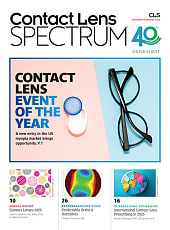Straight Up...With a Twist
Classic
style, with a small measure of edge, suits a large portion of today's 20- to
40-year-old male demographic. How can you reach this group with the right product?
By Erinn Morgan
They are manly men. With a soft side. The group in focus is men in their 20s to 40s who are both successful and somewhat style-conscious.
Unlike their metrosexual brothers, however, they are definitely not image-obsessed. A bit more laid back on the fashion front, they are the reason department stores generally place the men's clothing on the easy-to-reach first floor. Should eyewear retailers target the customer similarly?
It may not be a bad idea. According to a recent Reuters article, many companies are stepping up their marketing to men to work harder for this consumer's dollars.
For example, companies like Elizabeth Arden, Inc., plan to increase product offerings for men (the cosmetics giant recently signed a deal to develop a men's Daytona 500 fragrance line due in department stores next spring). Elizabeth Arden CEO Scott Beattie recently told attendees at the Reuters Consumer and Retail Summit in New York, "[Men] tend to not enjoy the same shopping experience as a woman...you have to be able to communicate more directly to them."
|
|
This relates to optical customers, too. "We men are a difficult bunch," says Jim Albright, owner of Albright Opticians in Lancaster, Pa. "For the most part, we are not shoppers. We are destination junkies who patronize a store that has the specific product we are looking for. Men go looking for a black suit and a pair of black shoes. One store, one hour, done! So how do we market to this Neanderthal mind?"
REACHING MEN
Certainly, this younger men's demographic is hard to target. How do you get them in the store? How do you appeal to their sensibilities once they are in the door?
Some retailers are taking on a newer, hipper look to appeal to a more modern man. For instance, the menswear retailer Casual Male Retail Group, Inc., plans to replace its decades-old yellow "Big & Tall" store logo with a more subtle name referring to what's inside. Signs and bags will sport the new "XL" logo by next spring.
Like department stores, optical shops can make the experience easier for this shopping-shy customer. Placing men's frames in a well-marked area near the front of the store is one way to approach the issue. Albright recommends merchandising men's product separately with strong point-of-purchase materials.
At Seattle Vision, an optometric practice in Seattle, all eyewear is merchandised by manufacturer, but manager Chad Sweitzer says they still separate out men's frames to help differentiate things for this customer. "Our men's product is merchandised more to the left and the women's more to the right."
He also notes that they always have one men's-specific P.O.P. item—for example, a poster of Will Smith wearing a Chrome Hearts frame with leather temples—that very effectively draws men's attention. "The men see that and say, 'Wow, Will Smith endorses these.'"
Albright also suggests advertising products specifically for men's wives or girlfriends: "If the wife comes to select a designer frame and is happy with her results, she will tell her husband where to look for his next pair of glasses."

Although many men in their 20s and 30s don't go into their
personal image as deeply as guyrs with metrosexual style, they appreciate good
looking frames. Shown Haggar style H 109 for i.Deal Optics.
Optical retailers can also advertise "something no one else advertises"—sports eyewear. Notes Albright: "If a man sees an advertisement for a smokin' pair of prescription sports glasses and he comes to see that frame... wham, he is in the store, and we have the opportunity to show him a stylish pair of optical frames, too."
Fashion Forward Today's man—especially the younger 20 to 40 market—is much more aware of fashion trends and generally has a stronger desire to look good. While he may still be a classic dresser and wary of looking too put together, experts say many men are actually taking a second look in the mirror before they leave the house. "There is a trend back to being a little bit better dressed," George Feldenkreis, CEO of Perry Ellis International, said at the Reuters Consumer and Retail Summit in New York. This shift in priorities also relates to men's eyewear choices; many are interested in better styling and even second pairs, say optical retailers. "For a variety of reasons, men are able to be more comfortable with a bolder look today," says Jon Martinez, director of public relations for Morgenthal-Frederics, a high-end optical chain with locations in in New York and Boston. "Part of it is that shows like 'Queer Eye for the Straight Guy' have helped enable the American man to feel ok with looking good without being over the top and too fashionable. He won't go too far out of the box." Even your most conservative customers may be more open to style advice than you think. "If we have a gentleman come in with a double-bar frame, you can bet he'll walk out with something up-to-date," says Lori Anderson, an optician at Dr. Texas Smith & Assoc., an optometric practice in Citrus Heights, Calif. "We say 'No, no, we don't do that here.' Most men are open to that and walk out the door in something more modern." |
|
|
Men are interested in durable frames that offer the latest technology. And once they find what they're looking for, men are likely to opt for high quality lenses and a pair of sunglasses in a similar style, as well. Shown top to bottom: Tommy Bahama style TB4 for Altair; Hart Schaffner Marx style D-301 for Signature Eyewear; and Tourneau style T027 for Tura

|
What a Guy Wants
Sure, many men want to look good. But dispensers say they are still more interested in things like durability, cutting edge technology, and gadgetry than brand names or styling when they are sitting at the dispensing table.
"A lot of men in their 20s and 30s want durable features," says Seattle Vision manager Chad Sweitzer. "Lots of them say, 'Honestly, I just don't have time to take care of my frame, so give me something durable.' In this case, we generally recommend a titanium frame, and we guarantee these for as long as the life of their prescription."
Sweitzer also says that men tend to be more interested in hearing what a frame or lens can do for them specifically. "Men are more willing to spend money on lenses than women because of this," he notes.
For this reason, he usually begins the dispensing process by asking what line of work the customer is in. "If they are in construction, for example, we will go with full metal frames in titanium," he says.
In addition, Martinez says that "men are usually more interested in the background of the frame and how it's made, as well as how it looks."
This dual interest can lead more men into buying second pairs of eyewear. "Because of the multiple interests, the male customer will connect with having two pair as being very useful," observes Martinez.
Jim Albright of Albright Opticians agrees that more men buy two pairs of eyewear than women. "Men just make it easy. 'Yeah, I like this, make me a pair of sunglasses, too.'"







